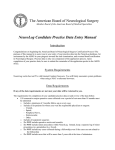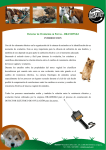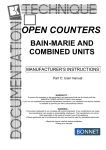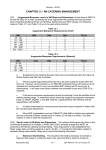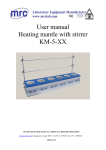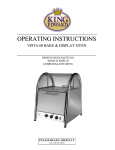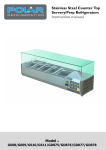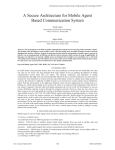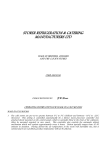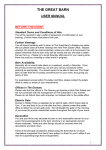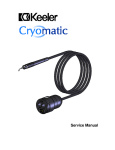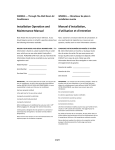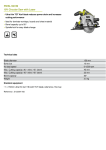Download SERVERY COUNTERS USER MANUAL
Transcript
STORER REFRIGERATION & CATERING MANUFACTURERS LTD SERVERY COUNTERS USER MANUAL DESIGN REVIEWED BY: G W Storer STORER COUNTER USER MANUAL OPERATING INSTRUCTIONS USE OF GRANITE DECKS AND CARVERY PADS SIMMERSTAT CONTROL Approximately 20 minutes before a serving session all hot decks in use should be switched on using the round red push button ON/OFF switch. The switch will be lit up when it is on. Next, set all simmerstats to full and run the decks up to temperature. When the decks are at operating temperature turn the simmerstats back down to setting number 2. (see note 1) HALOGEN LAMP HEAT LIGHTS Halogen lamps are fitted above heated surfaces on gantrys to heat food from above. All lamps are controlled by dimmers, which control from off to full steplessly. Turning a dimmer control knob clockwise will increase the brightness of the lights (see note 2) Depending on original specification and height of gantry, 200 watt, 300 watt or 500 watt lamps are fitted into clip in ceramic holders. Lamps should be changed only after the counter has been isolated from the mains supply. Please note that the surface of halogen lamps should never be touched with bare fingers, they come wrapped in tissue paper or foam, which should only be removed after the lamps are fitted. Note 1: Some decks made from darker granite e.g. balmoral red, which will absorb heat radiation from halogen lamps and carry on heating up even with the simmerstat turned completely off. Care should therefore be taken in how high dimmers are turned up. Note 2: Hot lamps are designed to give heat from above to a food servery. The wavelength of the light is such that of turned up too high it will continue to cook or burn food and heat up decks. It should, therefore, be noted that they should not be used as display lighting for food, as to supply sufficient lighting for this will almost certainly burn the food items. HOT CUPBOARDS Storer Hot Cupboards come in two specifications either convection or fan blown. The method of control is the same in both specifications. Each cupboard has a round red push button ON/OFF switch and a thermostat with a range of 30°C to 110°C. To use the cupboard, simply switch on using the push button switch (it will light up when on). Then, set the thermostat control knob to the required temperature setting. The sliding doors must be kept closed when not serving from it to maintain temperature. The doors are removed by tilting the door outwards and the spring-loaded guider pin must be depressed to release the door from the base so it can be tilted. The door is then unhooked from the overhead track. 1 The Hot Cupboard is not designed to heat food. All food placed in containers for service must be already at or above the desired service temperature. The Hot Cupboard should be cleaned with a damp (but not wet) Scotch Brite pad and a little detergent. Care must be taken not to bend the elements. BAIN MARIES Storer Bain Maries are controlled on simmerstats, dry well Bain Maries should be switched on using the push button on/off switch which will be lit up when on. The simmerstat should then be set to full until the Bain Marie reaches temperature then set the control back to 2. Wet well Bain Maries wherever possible should be filled with pre-heated water, as this will reduce the time required to reach operating temperature. All controls operate as per dry well Bain Marie. Storer use dry heat Bain Maries which should never be filled with water, and wet heat Bain Maries which have a stainless tank. The water level should be filled no higher than 40mm. All Storer wet heated Bain Maries have a drain off tap located under the Bain Marie, where the Bain Marie water can be drained off into a bucket. The Bain Maries are not designed to heat food; all food placed in containers for service must be already at or above the desired service temperature. Some Bain Maries are supplied with a stainless element cover. Care must be taken when cleaning the elements. A damp cloth should be used, the area being kept as dry as possible. Care must be taken not to bend the elements. HEATED PLATE LOWERATORS Plate Lowerators are self controlling and only need switching on at the push button on/off switch, once on, the switch will be lit up. They must be switched on well in advance of any session (approx. 1 hour) Adjustment to accommodate different weights of plate is effected by adding or removing springs. Springs must be placed symmetrically, otherwise the carrier will not slide freely. The unit should be adjusted so that about four or five plates are above the rim at a time. Allow 1 hour for heat up. Care must be taken when cleaning not to let water reach electrical components. BLOWN AIR DOLE WELLS Blown Air Dole Wells are designed to maintain 5°C or below. The air blows across the deck out of vertical grilles: it is essential that neither grille is obstructed in any way as the airflow efficiency of the refrigeration system will be restricted. This system is very effective in a draught free environment with an ambient temperature of no more than 26°C. Where ambient temperatures above 26°C or draughty conditions exist, the display will not maintain food temperatures at required levels. In all cases direct sunlight or bright spotlights must never be allowed to shine directly onto the 2 display area. The refrigeration system has an easy slide out condenser for ease of maintenance. The system is controlled by an electronic digital stat. with fan delay and automatic defrost. Displays with refrigerated storage underneath work off the same system. The doors are lockable. Cleaning The top section has lift out panels for easy cleaning. Cleaning should only be done when the system is switched off. A damp cloth must be used to wipe surfaces. To adjust electronic stat. see LAE fact sheet. Deli Glass Cleaning The front deli glass screens can be tilted forward. The bottom hinge track has a built in stop position,but it is strongly recommended that the weight of the deli glass is supported whilst in the open position by a second person during any cleaning operation.When the glass is in the fully open position it can be released from the bottom hinge track. Note that the weight of the glass screen ref patisserie 943 is 9Kg and ref patisserie 1243 is Kg MULTI-TIER COLD DISPLAYS This system offers chilled food display at countertop level and also on two or three shelves above. The food temperature is maintained at or below 5°C, by a stream of re-circulated cold air. The air normally blows down from a grille at the top front edge of the cabinet, returning to the fans and cooling coil through a horizontal grille or slot at the customers side of the countertop. Some air is directed across each of the shelves from small grilles or holes at the back of each shelf. It is essential that none of these grilles is obstructed in any way, as the airflow and refrigeration efficiency will be restricted. This system is very effective in a draught free environment with an ambient temperature of no more than 26°C as it does not cause drying of the displayed food. Where ambient temperature above 26°C or draughty conditions exist, the display will not maintain food temperatures at required levels. In all cases direct sunlight or bright spotlights must never be allowed to shine directly onto the display area. The temperature of the display is controlled by a digital indicator/thermostat (DIT). The DIT is mounted on the control panel above the compressor housing or close by. It will indicate the temperature of the circulating air at all times. Adjustment of the temperature is covered by LAE Facts Sheet. The same auto defrost system is used. Some Multi-Tier display units are built onto countertops and may have hinged doors to provide access from the rear for product replenishment. The doors, which incorporate magnetic gaskets, must be kept closed at all times except when access is required. . Other Multi-Tier display units are built into or up against walls so that they integrate totally into the room and are not seen as separate servery units. This system also saves space but since no rear access for loading is provided they must always be replenished from the front. REFRIGERATION CONDENSING UNITS At weekly intervals clean the condensing unit finned coils with a soft brush and commercial vacuum cleaner; take care not to push dust and dirt into the spaces between the fins. 3 Failure to carry out this instruction may reduce the efficiency of the refrigeration system to the end that safe storage temperatures may not be achieved and will invalidate the compressor warranty. If you are in any doubt about this instruction, telephone us for further information. New compressors are expensive. Check to see if your counter is fitted with compressors that pull out on slides; these are often fitted to higher specification and make this cleaning operation easier by improving access to the front of the compressor. FLUORESCENT LIGHT TUBES AND FITTINGS If the fluorescent lights fail to illuminate, isolate the counter from the mains supply and replace the tube with an identical unit. If this does not solve the problem, re-isolate the counter and replace the starter unit. On standard fittings it will be found in the body of the fitting housing and is normally a white cylinder 20mm in diameter and 35mm long. To remove it twist it anticlockwise about ¼ turn and pull gently. Ensure that the replacement is correctly rated to suit the light or fitting. If the light still fails to illuminate, call an electrician who will check the wiring and the ballast units. Please note all fluorescent fittings have a push button on/off switch located at the end of the light. GENERAL ELECTRICAL The main electrical circuits on the servery counter will normally be protected by miniature breakers (MCB's). The main supply will be controlled by an on/off switch mounted next to the MCB's at the bottom of the control panel. Depending on the size of the counter it may have more than one electrical supply and consequently more than one main switch and set of MCB's. Each circuit on the counter is provided with power through an MCB. In normal use the red switch on the MCB will be in the up position. If a fault develops the MCB will trip and act like a fuse by disconnecting the faulty circuit from the main supply. All other circuits should still function normally. On mobile units, you should ensure that trailing power connection cables are kept as short as possible and are not a hazard to others. When moving mobile units it is also important to prevent cables becoming trapped around the castors. Damage to sockets or switches could be a hazard to the operator if this as occurred report the fault and do not operator. Professional help should be sort to access the safe use of the equipment or repair needed CLEANING INSTRUCTIONS Brass and Copper The brass and copper on your counter is not lacquered and should be polished regularly using Goddards Long Term brass and copper polish. The frequency of cleaning will be determined by the particular conditions of your installation. Should serious discoloration of the brass or copper occur, this can be removed using T-Cut car polish which is available from any car accessory shop. After using T-Cut the brass or copper should be cleaned again using Goddards Long Term. Wire wool must never be used and care must be taken to avoid acids such as vinegar and lemon 4 juice from contacting brass or copper as rapid deterioration will occur. Glass Glass should be cleaned daily or as required using a proprietary glass cleaner. Care should be taken to select a cleaner with minimum odour to avoid food tainting. Hardwood Hardwood mouldings should be cleaned daily with a good quality spray on polish and treated properly once a week using a good quality, solid wax polish. All hardwood should be treated with the care that you would give to a piece of furniture in your own home. Laminates Clean daily with spray on furniture polish. Ceramic Tiles (Worktops) Wipe down daily with Jif or similar mild abrasive. Do not use wire wool, Vim or similar harsh abrasives. Pay particular attention to cleaning grout lines between tiles. If necessary use a medium stiff brush to clean grout lines. Once a week the Work tops should be wiped down using an odourless disinfectant such as Dettox. After cleaning, the Worktops may be polished using proprietary odourless furniture cleaner. Ceramic Tiles (Fascias) Wipe down daily using a damp cloth and a mild detergent. Once a week these should be cleaned with a good quality spray or polish. Granite Granite worktops should be cleaned after every meal service period using a damp cloth and a mild detergent. Care must be taken to ensure that the hot plates have been allowed to cool to a safe temperature before cleaning. Particular attention should be paid to the joint lines between the sections of granite. Once a week the worktops should be wiped down using an odourless disinfectant such as Dettox. After cleaning, the worktops may be polished using a proprietary, odourless furniture cleaner. Stainless Steel Stainless steel should be cleaned daily using a stainless steel polish, for example Amity stainless steel cleaner, as applied in accordance with the manufacturers instructions. Solid Surface Any general cleaner on a damp cloth such as Dettox and odourless furniture cleaner. 5






